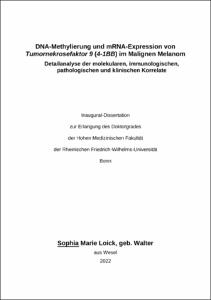DNA-Methylierung und mRNA-Expression von Tumornekrosefaktor 9 (4-1BB) im Malignen MelanomDetailanalyse der molekularen, immunologischen, pathologischen und klinischen Korrelate

DNA-Methylierung und mRNA-Expression von Tumornekrosefaktor 9 (4-1BB) im Malignen Melanom
Detailanalyse der molekularen, immunologischen, pathologischen und klinischen Korrelate

| dc.contributor.advisor | Dietrich, Dimo | |
| dc.contributor.author | Loick, Sophia Marie | |
| dc.date.accessioned | 2022-10-21T07:16:41Z | |
| dc.date.available | 2022-10-21T07:16:41Z | |
| dc.date.issued | 21.10.2022 | |
| dc.identifier.uri | https://hdl.handle.net/20.500.11811/10375 | |
| dc.description.abstract | Die Behandlung maligner Tumoren wurde durch die Einführung von Immuncheckpoint-Inhibitoren dramatisch verbessert. Allerdings sprechen bisher nur wenige Patienten auf diese Therapie an. Für eine Verbesserung der immunonkologischen Behandlung könnten daher zum einen alternative Immuncheckpoint-Modulatoren, zum anderen prädiktive Biomarker beitragen, anhand derer ein Patientenkollektiv mit einer voraussichtliche hohen Ansprechrate vorab identifiziert werden kann. TNFRSF9 (4-1BB) befindet sich sowohl als Ziel einer agonistischen Immuncheckpoint-Modulation in der klinischen Entwicklung als auch in der Diskussion als potenziell prognostischer Biomarker. Die DNA-Methylierung ist ein wichtiger epigenetischer Prozess, der unter anderem während der Karzinogenese und der Immunzelldifferenzierung eine relevante Rolle spielt und daher eine ideale Quelle für die Entwicklung von Biomarkern darstellt. Ziel dieser Arbeit war es, die detaillierte Analyse der DNA-Methylierung von TNFRSF9 im Malignen Melanom bezüglich der Eignung als Biomarker im Kontext von Immuncheckpoint-Modulatoren zu überprüfen.
Wir untersuchten die DNA-Methylierung von TNFRSF9 hinsichtlich der Zelltypspezifität (in Melanomzelllinien und isolierten Blutleukozyten), der Transkriptionsaktivität (mRNA-Expression), dem Gesamtüberleben sowie molekularen und Immunparametern (Immunzellinfiltraten, Lymphozytenscore und Leukozytenfraktion). Wir führten mit Daten der TCGA-Kohorte Korrelationsanalysen durch und validierten die Ergebnisse stichprobenartig mittels methylierungsspzifischer qPCR in einer Kohorte von Melanompatienten des UKB. Um die Eignung als prädiktiver Biomarker für das Ansprechen auf eine Immuntherapie zu testen, griffen wir auf eine mit Anti-PD-1 behandelte Patientengruppe zurück. | en |
| dc.description.abstract | Background: Immunotherapy, including checkpoint inhibition, has remarkably improved prognosis in advanced melanoma. Despite this success, acquired resistance is still a major challenge. The T cell costimulatory receptor TNFRSF9 (also known as 4-1BB and CD137) is a promising new target for immunotherapy and two agonistic antibodies are currently tested in clinical trials. However, little is known about epigenetic regulation of the encoding gene. In this study we investigate a possible correlation of TNFRSF9 DNA methylation with gene expression, clinicopathological parameters, molecular and immune correlates, and response to anti-PD-1 immunotherapy to assess the validity of TNFRSF9 methylation to serve as a biomarker.
Methods: We performed a correlation analyses of methylation at twelve CpG sites within TNFRSF9 with regard to transcriptional activity, immune cell infiltration, mutation status, and survival in a cohort of N = 470 melanoma patients obtained from The Cancer Genome Atlas. Furthermore, we used quantitative methylation-specific PCR to confirm correlations in a cohort of N = 115 melanoma patients’ samples (UHB validation cohort). Finally, we tested the ability of TNFRSF9 methylation and expression to predict progression-free survival (PFS) and response to anti-PD-1 immunotherapy in a cohort comprised of N = 121 patients (mRNA transcription), (mRNA ICB cohort) and a case-control study including N = 48 patients (DNA methylation, UHB ICB cohort). Findings: We found a significant inverse correlation between TNFRSF9 DNA methylation and mRNA expression levels at six of twelve analyzed CpG sites (P = 0.005), predominately located in the promoter flank region. Consistent with its role as costimulatory receptor in immune cells, TNFRSF9 mRNA expression and hypomethylation positively correlated with immune cell infiltrates and an interferon-g signature. Furthermore, elevated TNFRSF9 mRNA expression and TNFRSF9 hypomethylation correlated with superior overall survival. In patients receiving anti-PD-1 immunotherapy (mRNA ICB cohort), we found that TNFRSF9 hypermethylation and reduced mRNA expression correlated with poor PFS and response. Interpretation: Our study suggests that TNFRSF9 mRNA expression is regulated via DNA methylation. The observed correlations between TNFRSF9 DNA methylation or mRNA expression with known features of response to immune checkpoint blockage suggest TNFRSF9 methylation could serve as a biomarker in the context of immunotherapies. Concordantly, we identified a correlation between TNFRSF9 DNA methylation and mRNA expression with disease progression in patients under immunotherapy. Our study provides rationale for further investigating TNFRSF9 DNA methylation as a predictive biomarker for response to immunotherapy. Funding: AF was partly funded by the Mildred Scheel Foundation. SF received funding from the University Hospital Bonn BONFOR program (O-105.0069). DN was funded in part by DFG Cluster of Excellence Immuno-Sensation (EXC 1023). The funders had no role in study design, data collection and analysis, interpretation, decision to publish, or preparation of the manuscript; or any aspect pertinent to the study. | en |
| dc.language.iso | deu | |
| dc.rights | Namensnennung - Nicht kommerziell - Keine Bearbeitungen 4.0 International | |
| dc.rights.uri | http://creativecommons.org/licenses/by-nc-nd/4.0/ | |
| dc.subject | TNFRSF9 | |
| dc.subject | DNA methylation | |
| dc.subject | Melanoma | |
| dc.subject | Prognostic biomarker | |
| dc.subject | Predictive biomarker | |
| dc.subject | Immune cell infiltration | |
| dc.subject | Immune checkpoint | |
| dc.subject | Immunotherapy | |
| dc.subject | Response prediction | |
| dc.subject | 4-1BB | |
| dc.subject.ddc | 610 Medizin, Gesundheit | |
| dc.title | DNA-Methylierung und mRNA-Expression von Tumornekrosefaktor 9 (4-1BB) im Malignen Melanom | |
| dc.title.alternative | Detailanalyse der molekularen, immunologischen, pathologischen und klinischen Korrelate | |
| dc.type | Dissertation oder Habilitation | |
| dc.publisher.name | Universitäts- und Landesbibliothek Bonn | |
| dc.publisher.location | Bonn | |
| dc.rights.accessRights | openAccess | |
| dc.identifier.urn | https://nbn-resolving.org/urn:nbn:de:hbz:5-68433 | |
| dc.relation.doi | https://doi.org/10.1016/j.ebiom.2020.102647 | |
| ulbbn.pubtype | Erstveröffentlichung | |
| ulbbn.birthname | Walter | |
| ulbbnediss.affiliation.name | Rheinische Friedrich-Wilhelms-Universität Bonn | |
| ulbbnediss.affiliation.location | Bonn | |
| ulbbnediss.thesis.level | Dissertation | |
| ulbbnediss.dissID | 6843 | |
| ulbbnediss.date.accepted | 21.09.2022 | |
| ulbbnediss.institute | Medizinische Fakultät / Kliniken : Klinik und Poliklinik für Hals-Nasen-Ohrenheilkunde/Chirurgie | |
| ulbbnediss.fakultaet | Medizinische Fakultät | |
| dc.contributor.coReferee | Betz, Regina | |
| ulbbnediss.contributor.gnd | 1281889903 |
Dateien zu dieser Ressource
Das Dokument erscheint in:
-
E-Dissertationen (1991)




